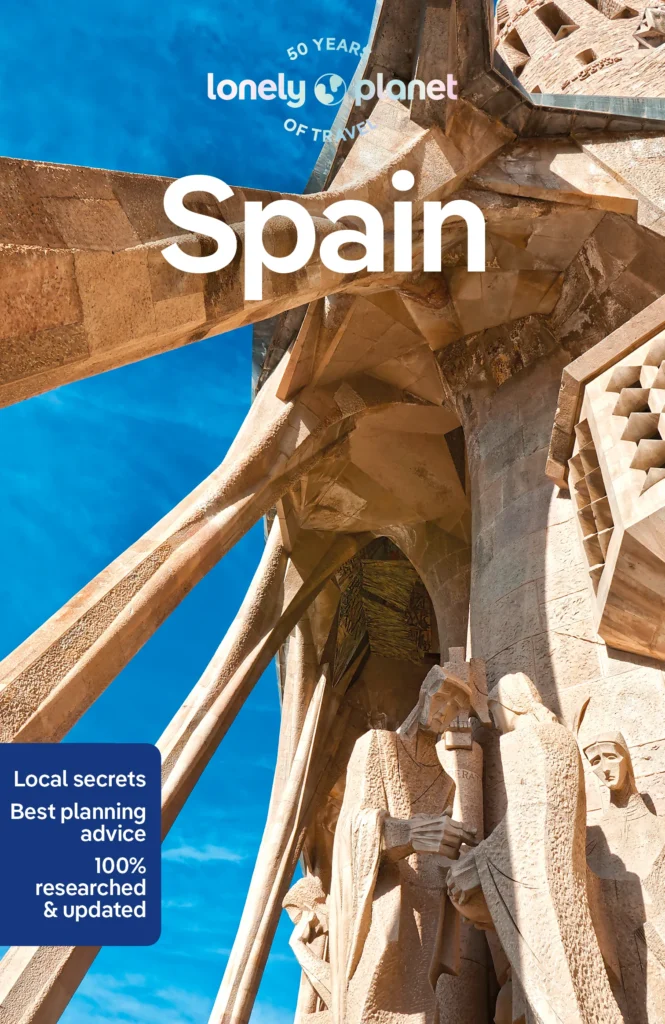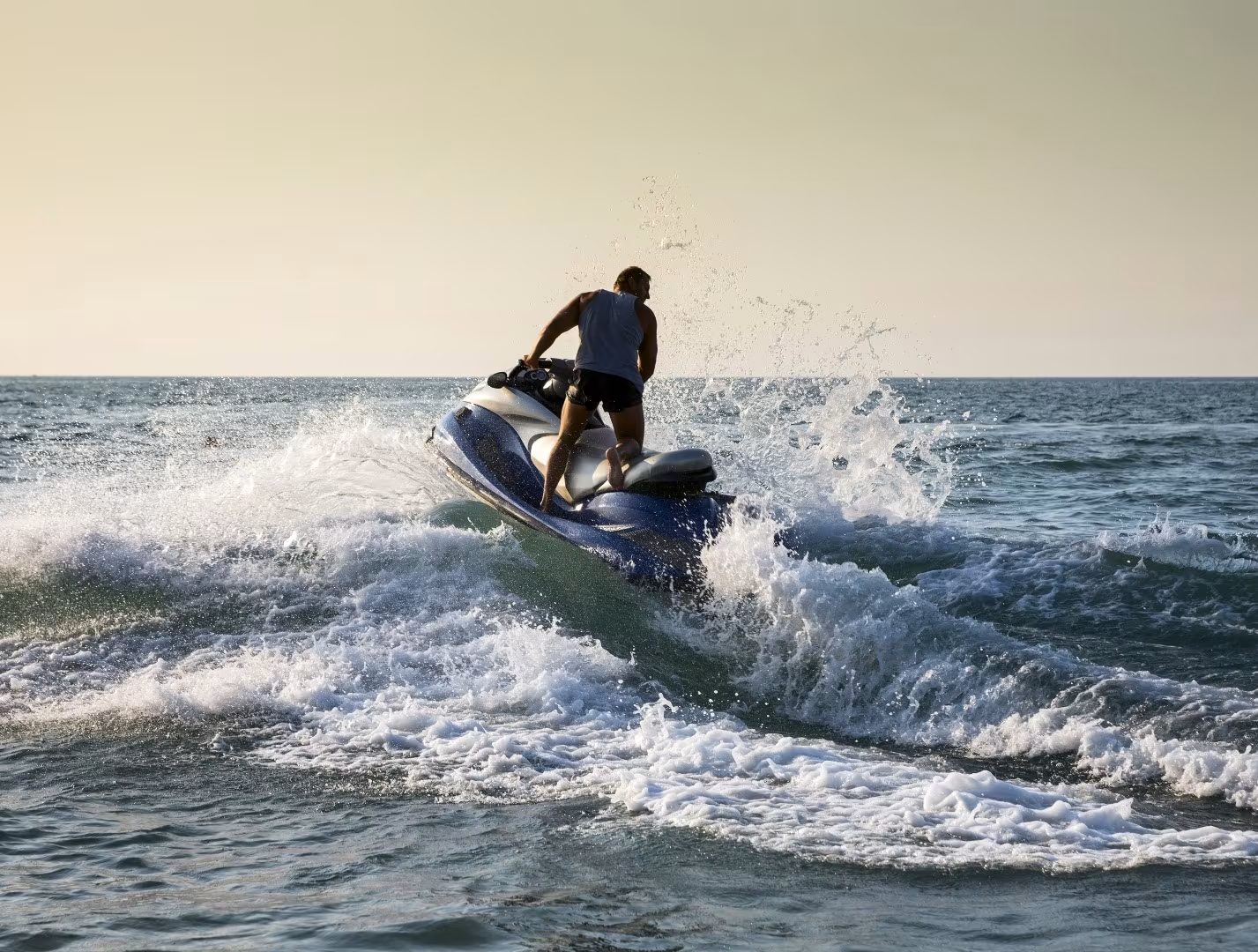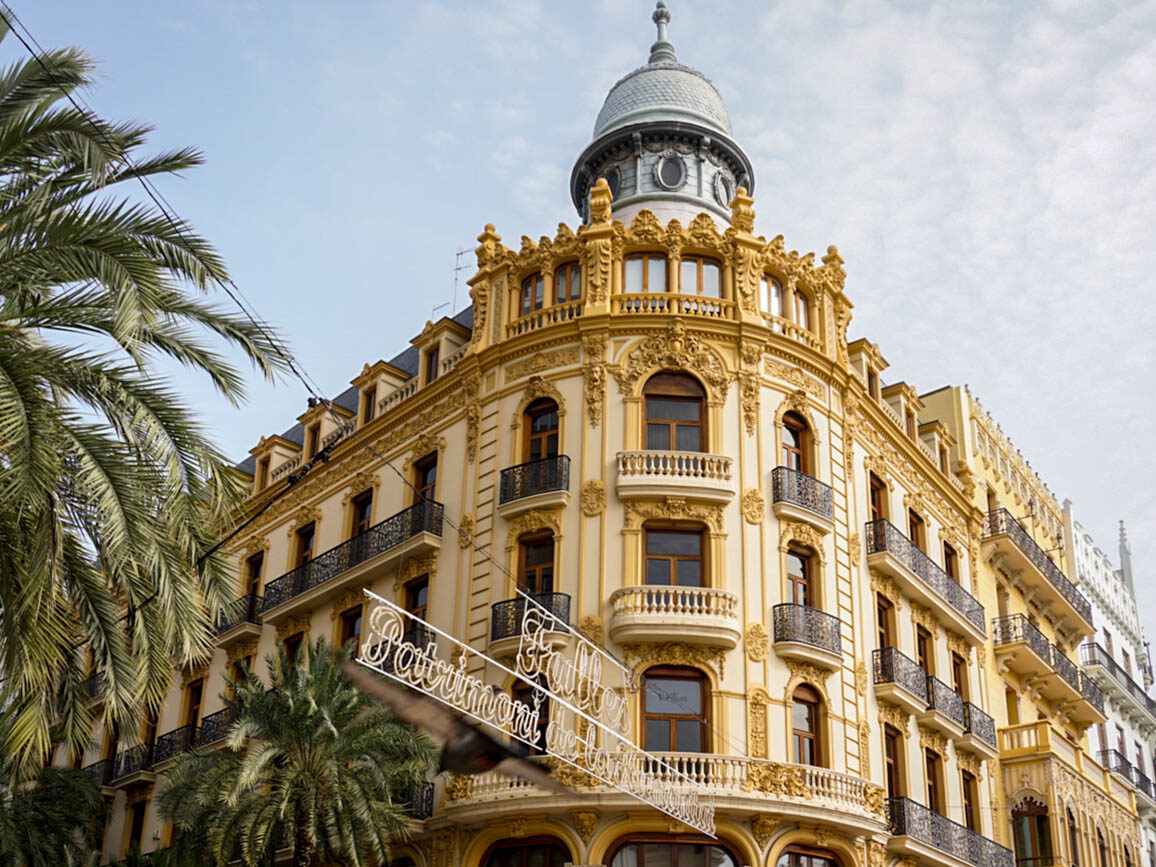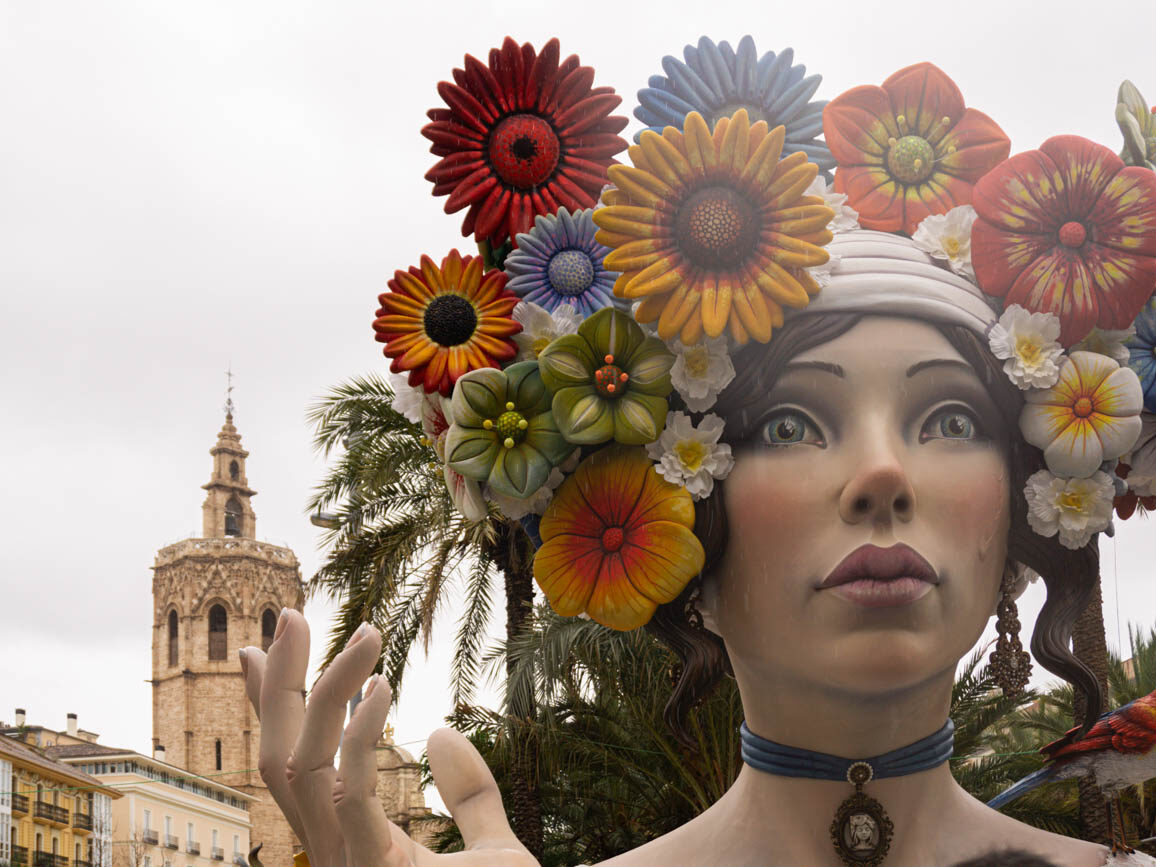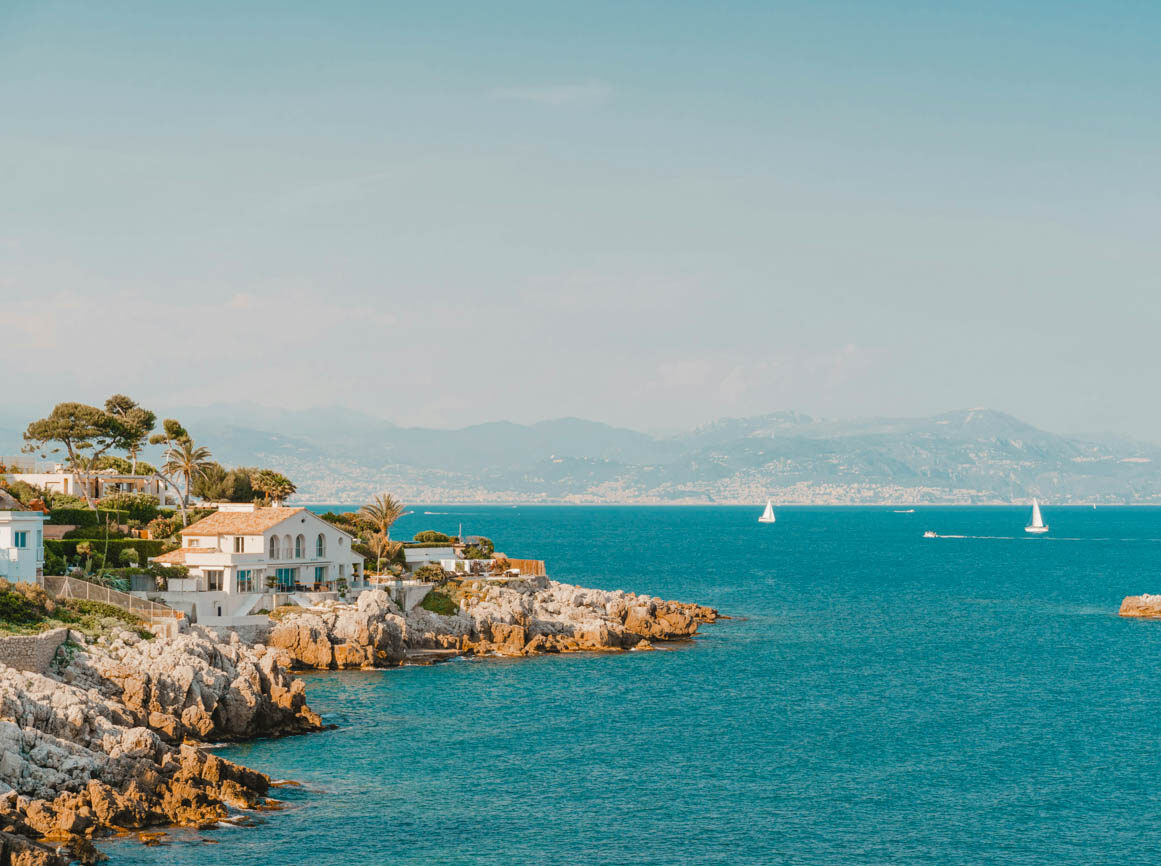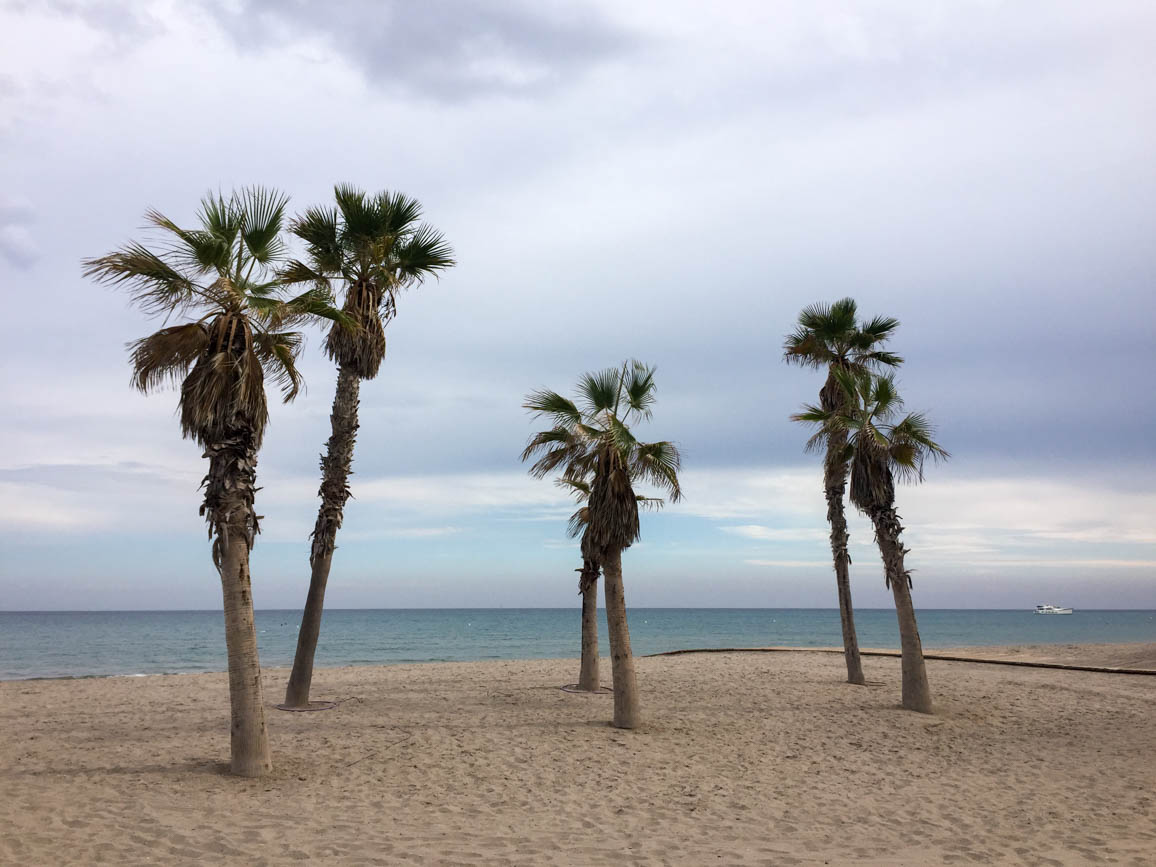
Things to do in Alicante (travel guide & map)
Overlooking the Mediterranean Sea, the city of Alicante (also known as Alacant) is the capital of the homonymous province, which in turn is part of the Valencian Community in southeastern Spain. Whether you’re visiting for the first time or returning to explore deeper (like I am in June!), in this comprehensive travel guide I’ll walk you through the best things to do in Alicante, what and where to eat, where to stay and some day trip ideas. At the end of this post, I’ve also included a map so you can easily pinpoint all the locations mentioned here.
***
Disclaimers:
- I first visited Alicante in November 2017 over a long weekend, when I was living in Geneva. But the trip was rather short because I also combined it with Valencia and I toured the city by night. This post has now been updated to reflect the latest information available to this date (and I´ll make sure to do so again after my upcoming trip in June).
- Please note that this publication includes some affiliate links. This means that, at no additional cost for you, I earn a commission if you make a purchase. In case you have any question about the companies advertised here or my status as an affiliate, please do not hesitate to contact me.
***
Throughout the trip, I used this Spain travel guidebook by Lonely Planet to plan our stay and make the most out of it. I hope you’ll find it helpful too!
🩵 Best things to do in Alicante
Welcome to the city of Alicante, also known as Alacant in the Valencian dialect! With a population of 381.000 as of 2025, this Mediterranean destination located at the foot of Mount Benacantil faces a beautiful bay.
Famous for its balmy weather virtually all year round, Alicante is a gem on Spain’s Costa Blanca, offering a perfect mix of historic landmarks, stunning beaches, mouthwatering food, and vibrant festive calendar. It is no wonder why Alicante is becoming increasingly popular!
Although I visited Alicante in 2017, I left with a long list of places I still wanted to see. Now, as I plan my next visit in June, I’ve put together the ultimate list of the best things to do in Alicante, mixing top-rated attractions with other activities you might want to include in your travel bucket list. Let´s get started!
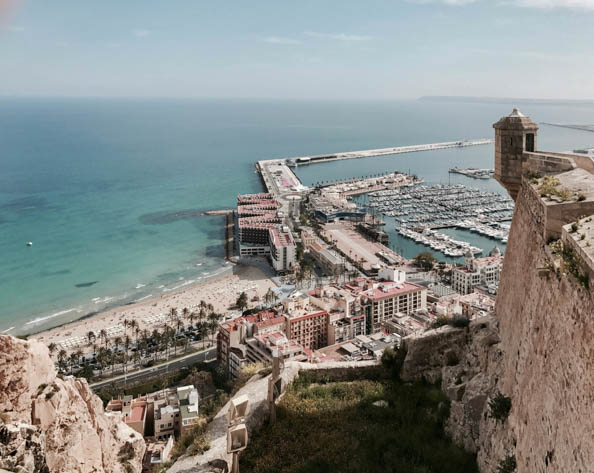
🏰 Visit the iconic Santa Bárbara Castle
If there’s one landmark that defines Alicante, it’s Santa Bárbara Castle (Castillo de Santa Bárbara). Sitting on top of the imposing Mount Benacantil at 166 meters above sea level, this medieval fortress offers spectacular panoramic views of the city, the bay of Alicante and the surrounding coastline.
This complex was built over time in very different eras and houses a museum (Museo de la Ciudad de Alicante – MUSA).
One of Alicante’s most intriguing legends is that of La Cara del Moro—the distinctive rock formation on Mount Benacantil, right below Santa Bárbara Castle. According to local folklore, this face-shaped silhouette tells the tragic love story of a Moorish king and a Christian princess. As the tale goes, the king’s daughter fell in love with a young Christian soldier, but their love was forbidden. Heartbroken, she threw herself from the castle walls, and in his grief, the king’s sorrow was forever etched into the mountain’s stone. Today, this natural landmark is one of the most photographed spots in Alicante, adding a touch of mystery to the city’s skyline. Can you spot the face when looking up from Playa del Postiguet?
There are various ways to get to the Castle of Santa Barbara, be it by car or taxi (convenient if you’re short on time), by foot (a steep but scenic walk up from the Old Town) or by elevator (located near Postiguet Beach, the round trip costs around €2,70).
🏛️ Explore Alicante’s historic Old Town (El Barrio de Santa Cruz)
Alicante’s Old Town (El Barrio de Santa Cruz or Casco Antiguo) is a charming mix of white-washed houses and peaceful squares in a maze of narrow streets that somehow reminds of Andalusia. Located right under the imposing Santa Bárbara Castle, this area comes particularly alive during the vibrant Alicante nightlife.
Some must-see spots in El Barrio include the following:
- Ayuntamiento: the Baroque Town Hall was built in the 18th century and is worth a visit for the Blue Room or its pink marble staircase, which features a metal disc that is used as a reference point to measure the altitude above sea level of any point in Spain.
- Basílica de Santa María: built on the former main mosque of the city, this is Alicante’s oldest church. Located at the foot of the castle of Santa Barbara, this temple has witnessed the local history through the centuries.
- Calle de los Labradores: this is possibly the most representative street of the Santa Cruz neighborhood, where the main Alicante families once had their residential mansions.
- Concatedral de San Nicolás de Bari: a stunning example of Spanish Baroque architecture from the early 17th century. It houses the Virgin of Remedio, who is venerated here as the patron saint of Alicante. The Communion chapel and the cloister are worth mentioning too.
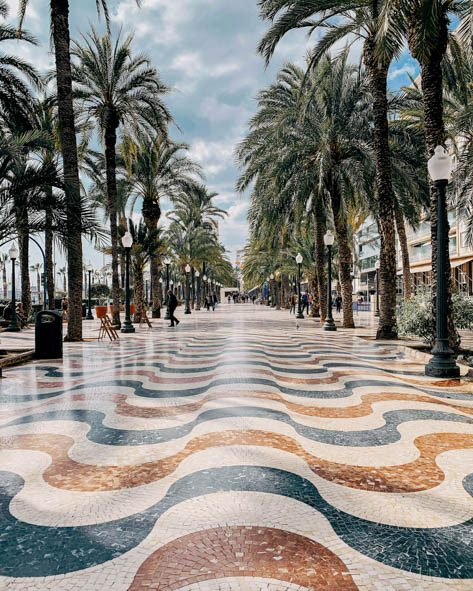
🌊 Walk the Explanada de España
The Paseo de la Explanada de España is one of Alicante’s most beautiful and iconic promenades. Considered the most popular pedestrian street in the city, it is almost 600 metres long and runs parallel to the port, connecting the Canalejas park to the Plaza Puerta del Mar, the nearby Marina and the Casino.
With its 6.5 million colorful tiles, palm-lined walkways, and lively street performers, this Explanada is the perfect spot for a relaxing stroll or a coffee break. Alongside it you will find tranquil fountains, statues devoted to local artists or the elegant Casa Carbonell built in 1925. So take your time, enjoy the sea breeze, and soak in the Mediterranean vibes!
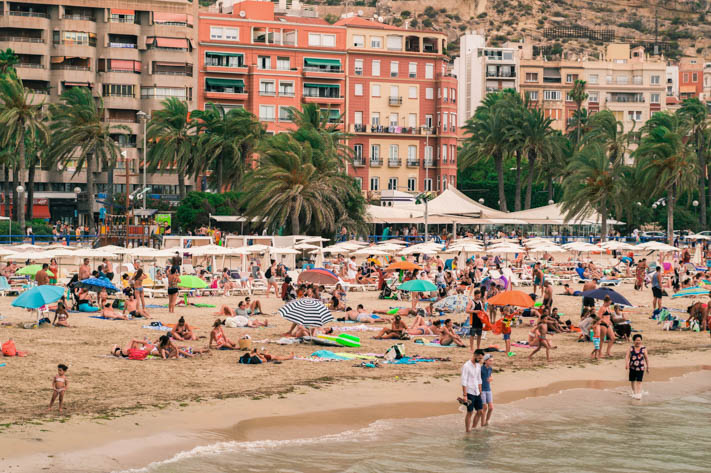
🏖️ Relax at Playa del Postiguet
Alicante is blessed with amazing beaches, but Playa del Postiguet is the most famous and convenient. Located right in the city center in front of Mount Benacantil and the Santa Bárbara Castle, this urban beach is perfect for sunbathing, swimming, and people-watching. Actually, it would be the Spanish equivalent of Praia de Copacabana in Rio de Janeiro, if you see what I mean. 😉
Feel free to check my section on beaches under ´Other things to do in Alicante´ for additional suggestions.
🌴 Wander Parque El Palmeral
If you’re looking for a peaceful escape from the city, Parque El Palmeral is a must-visit. This lush green oasis, located just south of Alicante’s center, is filled with towering palm trees, scenic walking trails, waterfalls, and picturesque bridges.
It’s the perfect spot for a relaxing stroll, a family picnic, or even a boat ride on the park’s small lake. Unlike the bustling beaches, El Palmeral offers a tranquil atmosphere where you can enjoy nature and unwind. If you’re visiting in summer, go early in the morning or late in the afternoon to avoid the midday heat!
🛥 Take a boat trip to Tabarca Island
Even though the island of Tabarca is actually closer to the nearby municipality of Santa Pola, it belongs to the city of Alicante. Visiting Spain’s smallest inhabited island, just a 40-minute ferry ride from Alicante, is probably one of the most popular excursions from this Mediterranean destination. You can also get here from Guardamar del Segura or Torrevieja.
With crystal-clear waters, charming white houses, and a rich pirate history, it’s a perfect day trip. Some of the things you can do in Tabarca, which was a former Genoese enclave, include snorkeling in the marine reserve, walking the historic walled town from the 18th century or trying the famous ´caldero´ seafood dish.
Please refer to my section on ´Day trips from Alicante´ for more ideas.
🐚 Other things to do in Alicante
In addition to the best things to do in Alicante listed below, you may want to add a few more depending on the activities you´re more interested in, from beaches to museums. The options are plentiful!
⛱ Beaches, coves and lighthouses
Hitting Playa del Postiguet, located right in the city center, is undoubtedly one of the best things to do in Alicante. That being said, this Mediterranean destination features a wide array of beaches and coves to choose from. Going north to south, these are the best beaches in Alicante: Playa de San Juan (7km long, quiet beach with extremely clear waters; we came here when I first visited the city although it was rather cloudy but I went for a quick dip nevertheless; I can´t wait to come back to enjoy the sunny weather here), Playa de las Huertas, Playa de la Almadraba, Playa de la Albufereta (less crowded, with a more relaxed vibe), Playa del Postiguet, Playa de San Gabriel, Playa de Agua Amarga, Playa de los Saladares and Playa del Saladar (also known as Playa de Urbanova).
While you´re at it, you may also want to stop by these idyllic coves in Alicante (called calas in Spanish): Cala de la Palmera, Cala Cantalar or Cala de los Judíos, which are near a lighthouse (Faro del Cabo de la Huerta). Don´t forget the beaches, coves and lighthouse in Tabarca island too!
Besides, the tram is really convenient to get to the beach in Alicante since it runs along the coastline and there´s always a sandy spot or dreamy cove a stone´s throw away.
See my section on ´How to get around Alicante´ for further details.
👀 Best panoramic views
If you´re looking for breathtaking vistas of the city of Alicante and its surrounding bay, head to the rocky promontories of Cabo de las Huertas or Cabo de Santa Pola.
Alternatively, the Santa Bárbara Castle or the Mirador de la Santa Cruz are great viewpoints too.
🌸 Gardens and parks
Alicante isn’t just about beaches—its beautiful parks offer a perfect escape into nature as well. These are some of the best parks in Alicante to enjoy outdoors:
- Panteón de Quijano: this small park lies steps away from the bull ring. Its charming green space with shaded benches is perfect for a quiet break.
- Parque de Canalejas: if you love tree-lined promenades, this one is a must-visit. Known for its massive ficus trees and elegant pathways, Alicante’s oldest park is the continuation of the iconic Explanada de España southbound.
- Parque de la Ereta: located on the slopes of Mount Benacantil, it provides breathtaking panoramic views of the city and the sea, making it an ideal spot for a peaceful walk or a sunset picnic.
- Parque El Palmeral: listed above as one of the best things to do in Alicante, this park is a true oasis for relaxation with its lush palm trees, waterfalls, and lake with rowing boats.
- Parque Monte Tossal: this massive park north of the city center offers a mix of leisure and sports, from hiking trails and outdoor gyms, to a skate park, making it a great choice for active travelers. It also houses the Castle of San Fernando.
🏛 Museums
Alicante houses enough museums to keep you entertained during your stay (or even longer). Here are some suggestions:
- MACA (Museo de Arte Contemporáneo de Alicante): this 17th century gallery located in the Plaza de Santa María displays paintings by talented Spanish artists such as Dalí, Miró, Picasso or Sempere.
- MARQ (Museo Arqueológico de Alicante): the museum exhibits a large number of archaeological pieces from prehistory to the modern age, including pieces of Roman and Iberian art.
- MUBAG (Museo de Bellas Artes Gravina): it houses an interesting collection of art from the 16th to the 20th centuries as well as numerous travelling exhibitions.
- MUSA (Museo de la Ciudad de Alicante): it is housed in the Santa Bárbara Castle.
- Museo de Aguas de Alicante: inaugurated in 2009, this space is devoted to promote knowledge and respect about the key role of water in the town’s daily life.
- Museo de Belenes: this museum is dedicated to the Spanish tradition of installing nativity scenes during Christmas.
- Museo de las Ilusiones: surprising museum full of captivating illusions.
- Museo de les Fogueres: this museum is dedicated to the popular bonfires held in June during the Saint John festival in the city.
- Museo Nueva Tabarca: this building, opened in 2004, highlights the island’s geographical, environmental, historical and ethnographic values.
- Museo Taurino: housed in the Alicante bull ring and dedicated to the bullfighting world.
- Museo The Ocean Race: interactive exhibition devoted to the Ocean Race sailing competition.
⛪ Religious temples
In addition to the Basílica de Santa María and the Concatedral de San Nicolás de Bari, other religious buildings worth mentioning in Alicante include Convento de la Preciosísima Sangre de Cristo (now vacant but initially built to house the Jesuits) or the Monasterio de Santa Faz (located five kilometers away from the city, it houses part of a cloth that is said to have wiped the face of Jesus Christ on his way to Calvary).
📸 Other historic buildings
Beyond its beaches and famous landmarks, Alicante is home to remarkable architectural treasures that showcase its rich history and culture. Here are some great examples:
- Castillo de San Fernando: a lesser-known fortress compared to Santa Bárbara, it offers a peaceful retreat with great city views from Monte Tossal and a glimpse into Alicante’s military past.
- Diputación Provincial de Alicante: its elegant, stunning neoclassical façade symbolize the province’s political and cultural significance.
- Palacio Maisonnave: located in the historic center, this beautifully restored 17th-century mansion, now serves as the Municipal Archive, preserving centuries of Alicante’s heritage.
- Teatro Principal: an architectural jewel from the 19th century, it continues to be a hub for performing arts, hosting everything from opera to contemporary theater.
Read these posts for more inspiration around the Valencian Community!
Las Fallas festival in Valencia (2025 guide): what to see, do and eat
Other Mediterranean destinations
Top things to do in Valencia: travel guide + map

📝 Travel tips: Alicante weather, key events and more
In case this is your very first time visiting the Spanish city of Alicante, here are a few tips to help you navigate this Mediterranean destination. For further details, head to my Spain destination page.
☀ Best time to visit
Thanks to its ideal location by the Mediterranean Sea, the weather in Alicante is pleasant virtually all year round. Having said that, the whole Valencian Community, particularly the coastline, is very popular among tourists during the summer.
If you can, travel to Alicante during the shoulder season instead (be it spring, fall or even winter) to avoid large crowds while still enjoying the balmy climate.
🗓 Key events
Alicante is a city that loves to celebrate, with vibrant festivals happening all year round. The most famous is Hogueras de San Juan (Fogueres de Sant Joan), held June 20-24 around Plaza de los Luceros, a fiery spectacle similar to Valencia’s Fallas, featuring huge artistic bonfires, fireworks, and lively street parties. This celebration is then followed by the Fiestas de San Pedro from June 25-29, bringing more traditional festivities. In August (3-5), the city honors its patron saint during the Fiestas de la Virgen del Remedio, with religious events and local traditions.
December 4-8 sees the thrilling Moros y Cristianos, a dramatic reenactment of the battles between Moors and Christians, though it shouldn’t be confused with nearby Alcoy’s famous version.
Other key events include the Porrate de San Antonio (January 17), Carnival (February/March), the deeply spiritual Semana Santa (Holy Week), and the Peregrina de la Santa Faz, a major pilgrimage taking place the Thursday after Easter week.
⏳ Historic background
Alicante’s history dates back over 5,000 years, with prehistoric settlements from the third millennium BC. The city’s urban origins began around the 4th century BC when the Iberians founded a colony that later became the Roman city of Lucentum (you can actually visit those remains in the archaelogical site of Tossal de Manises). Following centuries of Arab rule, the population moved to Mount Benacantil’s southern slopes, establishing Vila Bella in the 9th century, the foundation of Alicante’s medieval medina.
The city was later conquered by Castile, integrated into the Kingdom of Valencia, and became part of the Crown of Aragon. Today, Alicante is the capital of its province, renowned for its Mediterranean beaches, rich heritage, and status as a major European hub—home to the European Union Intellectual Property Office (EUIPO) since 1994.
📍Itinerary
The city can be easily visited in one day, which should give you sufficient time to explore some of the best things to do in Alicante. However, you may wish to stay longer to take it easy or explore nearby destinations such as Tabarca Island (see my suggestions below in the section ´Day trips from Alicante´).
This would be my suggested itinerary if you´re spending 24 hours in the city of Alicante:
- Start the day by heading to the iconic Santa Bárbara Castle, then explore the charming Old Town and walk along the Explanada de España.
- For lunch, you can try the delicious local cuisine near Playa del Postiguet or in the Marina.
- In the afternoon, take the tram and relax at one of the endless Alicante beaches or coves, for example around Playa de San Juan. Finish on a high note with an al fresco dinner and drinks in that area, and thank me later! 🙂
💬 Language
Most people in Alicante speak both Spanish and Valencian, which is a local dialect similar to Catalan or Majorcan. Expect locals in touristy spots such as major attractions, hotels and restaurants to speak decent English too.
🛟 Safety
Alicante is a very safe city, but watch out for pickpockets in tourist areas. For extra peace of mind when traveling abroad, you can calculate how much you would pay for your health insurance with the SafetyWing widget below.
🍽 What and where to eat in Alicante
What to eat in Alicante: rice and much more
As in Valencia, the most popular dishes of the cuisine in Alicante revolve around rice (known as arroz in Spanish or arrós in Valencian). Beyond delicious rice recipes, the city of Alicante and its province have much more to offer, from mouthwatering starters and salads, to fresh seafood and sweet desserts and even wines.
Listed below are some traditional products you can eat in Alicante. Bon profit!
- 🥖 Appetizers and tapas: if you would like to eat a snack (known as picaetes) during your stay in the city, you could try grilled squid, cold meats or croquettes, best enjoyed in the lively tapas bars along Explanada de España or Calle Mayor. Small sandwiches (montaditos) are a good choice too.
- 🥘 Rice: as mentioned earlier, rice is truly THE star of the local cuisine, with endless variations like paella alicantina (with chicken, tuna, squid and seafood), arròs a banda (a flavorful seafood rice dish), arròs negre, arroz con costra, and the famous caldero seafood dish from Tabarca.
- 🦞 Seafood: foodie lovers can indulge in red prawns (gamba roja), langoustines (cigala), sea urchins (erizo de mar), mussels (mejillones), and lobster (langosta), all freshly caught from the Mediterranean.
- 🍷Wines: Alicante’s wines, protected under the Denominación de Origen Alicante, range from rosé and red wines to the famous Fondillón, a unique aged sweet wine.
- 🍯 Desserts: to finish your meal on a high note don’t miss the nougat (turrón from both Alicante and Jijona varieties are eaten all over Spain during Christmas), fig bread (pan de higo), almond pastries, tiger nut milk (horchata), and refreshing slushes (granizados).
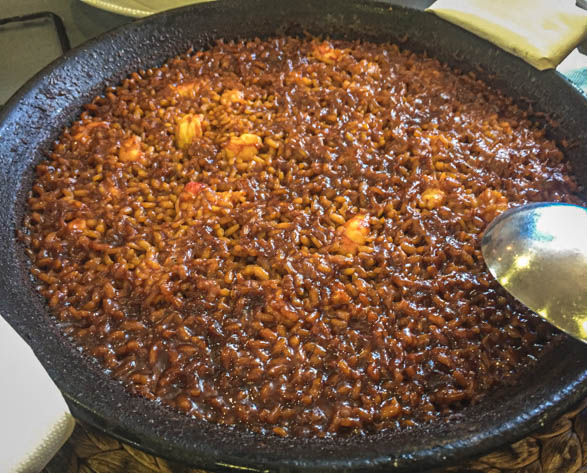
Where to eat: best restaurants in Alicante
There are endless places where you can eat delicious food in Alicante, from paellas or fresh seafood to horchatas and ice creams. Below are some spots that I’ve tried myself or that were recommended by friends and locals, sorted by category for your ease of reference. Enjoy and feel free to let me know how you liked them in the comments!
- 🍻 Bars, clubs and tapas: for traditional tapas and cocktails, head to Calle Mayor or Calle San Francisco (also known as Calle de las Setas for its big mushrooms) in the Old Town or walk along Explanada de España. You will find upscale bars with ocean views in the Marina and the harbor area (muelle de Levante), whereas Calle Castaños is the heart of the nightlife scene. During the summer months, partygoers enjoy spots near the beaches of San Juan and El Campello.
- ☕ Cafeterias and ice-cream parlors: Hermanas Martínez, Kiosco Peret, Madness.
- 🍅 Markets and food shops: the main market in the city is Mercado Central de Alicante, although you will find others spread around town (Mercado de Babel, Mercado de Benalúa, Mercado de Carolinas). If you would like to bring a foodie souvenir back home, I suggest you check Bodega Bernardino, Damas or Turrones Carbonell.
- 🍽️ Restaurants: Cervecería La Gamba (we had some rather standard seafood for dinner), Dársena, El Bodegón (we had a heavenly rice dish here and I can’t wait to come back, 100% recommend), El Portal, Infraganti Pizza, La Ereta (with panoramic views), La Taberna del Gourmet, Maestral, Mauro, Mesón de Labradores, Nou Manolín, Monastrell, One-One (French cuisine), Peccati di Gola (we enjoyed a beer and a snack at this Italian restaurant), Piripi, Racó del Pla.
Do you like my content? Subscribe to my newsletter to stay tuned.
🛏 Where to stay in Alicante
When I first visited Alicante, we slept at a friend´s apartment in San Juan. If you’re wondering where to stay in the city, here’s a selection of Alicante hotels and hostels sorted by budget:
- Luxury hotels in Alicante (⭐⭐⭐⭐⭐): Hospes Amérigo, SIDI Resort.
- Medium range hotels in Alicante(⭐⭐⭐ or ⭐⭐⭐⭐): Abba Centrum Alicante, Hotel Albahía, Hotel Alicante Gran Sol, Hotel Almirante, Hotel Boutique Alicante, Hotel Boutique Isla Tabarca, Hotel Les Monges Palace Boutique, Hotel Maya Alicante, Innside Alicante Porta Maris, Meliá Alicante, Occidental Alicante.
- Budget accommodation in Alicante (⭐⭐ or below): Hotel San Remo.
For more accommodation options in Alicante, feel free to check out Airbnb, Booking or Hostelworld, my go-to platforms wherever I travel.

🚌 How to get around Alicante
Getting around Alicante is easy and convenient since the city is manageable to explore on foot, especially in the Old Town, the Marina, and the beachfront areas. For longer distances, the city offers efficient public transport, including trams, buses, and taxis. Visitors can use the Móbilis Card, a rechargeable ticket that provides discounted fares on buses and trams, making it a budget-friendly option for getting around.
Let´s now see the various options to get around in Alicante so you can pick the most convenient for your trip.
- 🚲 By bike: there are plenty of bike lanes to get around Alicante on two wheels. You may rent a bike from several local companies such as Alicante by Bike, Blue Bike, ListNride or Rent Point.
- 🛥️ By boat, cruise or ferry: Alicante being a Mediterranean city, getting here by water is a natural option. You may hop on a boat for a day trip excursion to Tabarca Island with Cruceros Kon Tiki or Flying Cruiser. If you´re into water sports, you can stop by various facilities such as Club Náutico Alicante Costa Blanca, Real Club de Regatas or the Marina. Should you be traveling to destinations in Northern Africa such as Alger or Oran, head to the city´s cruise terminal. If you would like to visit Ibiza from Alicante, you will need to catch a ferry from Dénia.
- 🚌 By bus: buses in Alicante cover the entire city as well as the surrounding areas, connecting key attractions and neighborhoods. For sightseeing, you can hop on the tourist bus (Turibus). In case you´re traveling by bus to other places throughout Spain, make your way to the bus station (Estación de Autobuses de Alicante).
- 🚙 By car: in my opinion, a car rental in Alicante is only needed if you plan to visit remote beaches or the countryside. Otherwise, just walk or use public transport and forget about parking.
- 👣 By foot: walking is often the best choice, especially to explore the Old Town and the nearby beaches.
- ✈️ By plane: the Alicante airport (Aeropuerto de Alicante -Elche Miguel Hernández, ALC) is located a short 15 min drive from the city. You can conveniently get there by bus, car, tram or taxi. Given its pleasant weather, you will luckily find many flights to Alicante all year round. For example, when I was working as an expat in Geneva, I flew through Madrid and then via Barcelona on the way back.
- 🚕 By taxi: taxis are available in town, although they´re not as cheap as public transport. You may also use ride-hailing apps such as Cabify or Uber in Alicante.
- 🚂 By train: the Alicante train station connects with major Spanish cities such as Barcelona, Córdoba, Madrid, Málaga, Santiago de Compostela, Sevilla or Valencia.
- 🚋 By tram: running mostly along the coastline, Tram Alacant is a great way to reach San Juan beach and other nearby towns such as El Campello, Benidorm, Altea, Calpe or Denia. If you would like to go beach hopping and don´t want to hire a car, the tram is your best bet. Besides, the TRAMnochador provides a night service that operates on summer weekends. During my stay in 2017, we actually took the tram to go from our apartment in San Juan to the Old Town and we found it really convenient.
Feeling adventurous? Check out these outdoor activities with Manawa in Alicante.
Canyoning at La Mela in Abdet, near Alicante
Jet Ski Guided Excursion from Benidorm Port
Parasailing from Villajoyosa, near Benidorm
Quad Biking excursion to Algar Waterfalls in Benidorm
Tandem Paragliding Flight from Santa Pola, Alicante
Via Ferrata K4 in Redován, close to Alicante
🗺 Alicante map
For your ease of reference, below you will find an Alicante map with all the spots mentioned throughout this blog post, including the best things to do in Alicante, where to eat or stay. Save it and use it to plan your next trip!
🧳 Day trips from Alicante
Located by the Spanish Mediterranean shores, the southeastern Valencian Community encompasses three provinces. Going north to south, these are namely Castellón, Valencia and Alicante, named after their homonymous capital cities.
The coasts of this region are highly popular summer resorts for both Spaniards and foreigners, even though the balmy weather guarantees a sunny stay virtually all year round.
In this section, I´ll be sharing some ideas of suggested day trips around the province of Alicante, featuring both coastline and inland destinations.
Costa Blanca: Alicante´s coastline
The White Coast (known as Costa Blanca) occupies a privileged strip of the Spanish Mediterranean and is quieter than the Costa del Sol and with milder winters than the Costa Brava in Catalonia. The city of Alicante is the arrival and departure point for almost all tourism to this area.
Starting north and heading south, these are the destinations you might want to stop by along the Costa Blanca:
- Denia (or Dénia): this ancient Greek colony is currently a fishing port and summer resort town. Its urban centre surrounds a hillock at the top of which you can reach a large castle. Other attractions worth mentioning in Dénia include the archaelogical museum and the church of Santa Ollaria. Ferries depart from Denia to Formentera in the Balearic Islands (which is what we´ll take during our upcoming van road trip in June).
- Jávea (or Xàbia): an old pirate refuge, here you will find some of the most idyllic beaches, cliffs and coves on the entire Alicante coast.
- Calpe: this municipality is well known for its beaches, but above all for the imposing Peñón de Ifach, a huge limestone formation with a great variety of birds which reminds me of Gibraltar. Another Instagrammable location in Calpe is an iconic castle-like building (Muralla Roja) designed by Spanish architect Ricardo Bofill.
- Altea: known as the dome of the Mediterranean, this well-preserved white old town on top of a hill features a long pebble beach at its feet. The most iconic monument in Altea is devoted to Nuestra Señora del Consuelo and has two blue glazed ceramic domes that are visible from all over the city.
- Benidorm: once a small fishing village, Benidorm grew exponentially during the Spanish boom of tourism in the 1960s, thus becoming the most popular destination on the Costa Blanca. In addition to its famous beaches (playas de Levante y Poniente) and towering skyscrapers, head to the iconic viewpoint (Balcón del Mediterráneo) for unforgettable views. You can also have fun at the Terra Mítica amusement park, which opens in selected dates from May to November.
- Villajoyosa (or Vila Joiosa): this Mediterranean seaside town is one of the most picturesque along the Costa Blanca. Make sure to capture the colorful houses along the promenade as well as the photogenic hanging houses overlooking the Amadorio river. To finish on a sweet note, discover the history of the local company Chocolates Valor at the Chocolate Museum.
- Santa Pola: this active fishing port attracts a large number of visitors thanks to its long beaches. Santa Pola is also the closest point to reach the island of Tabarca.
- Torrevieja: before the tourist market boomed in the 80s, Torrevieja´s source of wealth was its salt mines, which were the most productive in Europe. Torrevieja is nowadays a very popular summer resort with wide sandy beaches.
The countryside in Alicante province
Even though the Costa Blanca draws millions of visitors to its coastline, there are a few destinations worth exploring inland too. Let´s find out more about them.
- Alcoy (also known as Alcoi): surrounded by high mountains with endless almond and olive trees, this industrial city is known above all for the simulated battles of Moors and Christians celebrated at the end of April to commemorate the struggles of the Spanish Reconquista, and for its famous sugared almonds (peladillas).
- Elche (or Elx): one of the biggest attractions in town is its gigantic palm grove (Palmeral de Elche), considered a UNESCO World Heritage Site. You will also find various copies of a stone bust known as The Lady of Elche scattered across the city, representing an Iberian priestess from the 5th century BC. Last but not least, the Basilica of Santa Maria built in the 17th century houses the Misteri d’Elx celebrations in August 11-15, a choral work performance with striking special effects.
- Guadalest: this pretty mountain village remains relatively unspoiled due to its difficult access. The most iconic attractions in Guadalest include the ruins of the castle and the characteristic bell tower of the church, that are perched on a rock. You can also visit the Museum of Miniatures.
- Jijona (or Xixona): this inland destination is dominated by its castle. When wondering the old town, make sure to visit the museum dedicated to the famous soft nougat (Museo del Turrón de Jijona), a staple during Christmas celebrations in Spain together with the harder nougat known as turrón de Alicante.
- Novelda: apart from its marble factories, the most interesting thing about this industrial city are its various modernist buildings, including the Casa-Museo Modernista built in 1903.
- Orihuela: located on the border with the Region of Murcia, this prosperous city welcomed the Catholic Monarchs on their way to Granada back in the 15th century. Nowadays, you can admire a painting by Velázquez in the Gothic cathedral or visit various museums such as Museo Arqueológico San Juan de Dios or Casa-Museo de Miguel Hernández.
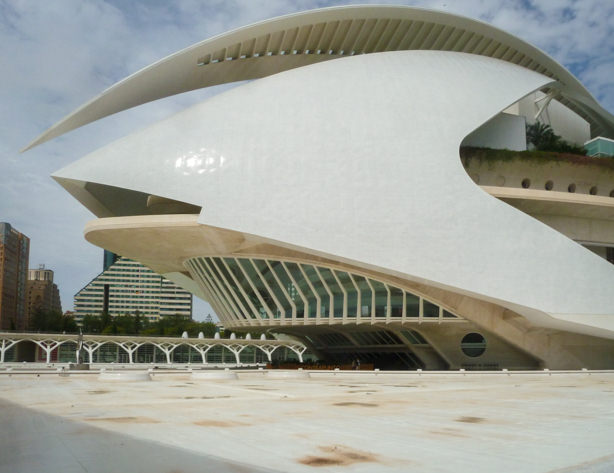
While you’re in Alicante, you may also visit the neighboring provinces of Castellón (including Castellón de la Plana or Peñíscola) or Valencia (see my section on ´Day trips from Valencia´ for more ideas such as Buñol, Gandía, Oliva or Xàtiva).
Browse more Mediterranean destinations in Spain!
Formentera (coming up soon)
Ibiza (coming up soon)
Mallorca (coming up soon)
Menorca (coming up soon)
💭 Final thoughts on Alicante
As you can see, Alicante truly has something for everyone whether you’re into history, beaches, food, or nightlife. My 2017 visit was short and sweet, and I can’t wait to explore even more in June with my Dad before heading to the Balearic Islands.
I hope this comprehensive travel guide detailing the best things to do in Alicante was helpful to plan your next trip. Feel free to leave your questions and comments below, or show your support by loving this article. I look forward to hearing how your stay goes!
✈️ Curious to know where I’ll be traveling next? ✈️
Stay tuned by following me on social media (Instagram, X, Facebook) and subscribe to my newsletter for regular updates!
In the meantime, safe travels around the world!
***
| GET READY FOR YOUR NEXT TRIP! |
|---|
| Browse my travel resources page to plan your upcoming trip. |
| Feeling adventurous? Book any outdoor activities worldwide with Manawa! |
| Get medical or health insurance via SafetyWing for extra peace of mind. |
| Looking for sports equipment? Feel free to browse my Decathlon profile for inspiration. |
| Use the comprehensive and helpful Anaya Touring or Lonely Planet travel guidebooks to plan your trip. |
| Book memorable activities and tours around the world with Get Your Guide. |
| Use your Revolut Card to pay in local currency when you’re traveling abroad! |

